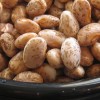 Todos nosotros tenemos bacterias buenas por todo nuestro cuerpo. Una población grande de bacterias vive en nuestro tracto gastrointestinal, mayormente en el colon (intestino grueso). Esto se conoce como nuestra flora intestinal. This 2-page fact sheet was written by Wendy J. Dahl and Volker Mai, and published by the UF Department of Food Science and Human Nutrition, October 2012.
Todos nosotros tenemos bacterias buenas por todo nuestro cuerpo. Una población grande de bacterias vive en nuestro tracto gastrointestinal, mayormente en el colon (intestino grueso). Esto se conoce como nuestra flora intestinal. This 2-page fact sheet was written by Wendy J. Dahl and Volker Mai, and published by the UF Department of Food Science and Human Nutrition, October 2012.
http://edis.ifas.ufl.edu/fs202
Tag: Wendy Dahl
De compras para la salud: Frijoles, guisantes y lentejas (FSHN1105S/FS201)
 Las legumbres son unos de los alimentos más completos en la naturaleza que proveen una gran variedad de beneficios para la salud. Las legumbres tienen mucha proteína, fibra y vitaminas. También son bajas en grasa, no tienen colesterol y son muy bajas en grasa saturada. Los frijoles oscuros tienen alto contenido de antioxidantes. This 4-page fact sheet was written by Lakshmi Mahan, Lauren Foster y Wendy J. Dahl, and published by the UF Department of Food Science and Human Nutrition, October 2012.
Las legumbres son unos de los alimentos más completos en la naturaleza que proveen una gran variedad de beneficios para la salud. Las legumbres tienen mucha proteína, fibra y vitaminas. También son bajas en grasa, no tienen colesterol y son muy bajas en grasa saturada. Los frijoles oscuros tienen alto contenido de antioxidantes. This 4-page fact sheet was written by Lakshmi Mahan, Lauren Foster y Wendy J. Dahl, and published by the UF Department of Food Science and Human Nutrition, October 2012.
http://edis.ifas.ufl.edu/fs201
De compras para la salud: Leche (FSHN1109S/FS200)
 La leche ofrece una variedad de nutrientes esenciales que el cuerpo necesita para mantenerse saludable. Estos nutrientes incluyen el calcio, la vitamina D, la vitamina A y el potasio. La leche también contiene proteína de alta calidad que ayuda a satisfacer las necesidades de su cuerpo. This 4-page fact sheet was written by Wendy J. Dahl and Lauren Foster, and published by the UF Department of Food Science and Human Nutrition, October 2012.
La leche ofrece una variedad de nutrientes esenciales que el cuerpo necesita para mantenerse saludable. Estos nutrientes incluyen el calcio, la vitamina D, la vitamina A y el potasio. La leche también contiene proteína de alta calidad que ayuda a satisfacer las necesidades de su cuerpo. This 4-page fact sheet was written by Wendy J. Dahl and Lauren Foster, and published by the UF Department of Food Science and Human Nutrition, October 2012.
http://edis.ifas.ufl.edu/fs200
De compras para la salud: Yogurt (FSHN1201S/FS198)
 El yogur se ha convertido en un producto muy popular en la dieta de los Estadounidenses y se ha apoderado de la mayoría de la sección de los productos lácteos en muchas tiendas. ¿Alguna vez se ha preguntado qué es el yogur, cuáles son los beneficios para la salud o cuál es la diferencia entre los tipos de yogures? Continúe leyendo para encontrar las respuestas a estas preguntas y para aprender más sobre el yogur.This 3-page fact sheet was written by Stephanie B. Meyer, Ada Medina-Solórzano y Wendy J. Dahl, and published by the UF Department of Food Science and Human Nutrition, October 2012.
El yogur se ha convertido en un producto muy popular en la dieta de los Estadounidenses y se ha apoderado de la mayoría de la sección de los productos lácteos en muchas tiendas. ¿Alguna vez se ha preguntado qué es el yogur, cuáles son los beneficios para la salud o cuál es la diferencia entre los tipos de yogures? Continúe leyendo para encontrar las respuestas a estas preguntas y para aprender más sobre el yogur.This 3-page fact sheet was written by Stephanie B. Meyer, Ada Medina-Solórzano y Wendy J. Dahl, and published by the UF Department of Food Science and Human Nutrition, October 2012.
http://edis.ifas.ufl.edu/fs198
De compras para la salud: Guia de comidas congeladas (FSHN1202s/FS199)
 Sin embargo, con la gran variedad de comidas congeladas que están ahora en las tiendas de alimentos, es posible expandir sus opciones de alimentos y seguir consumiendo comidas apetitosas y saludables. La clave está en saber qué buscar cuando está comprando. Para aprender como escoger comidas deliciosas que satisfagan sus preferencias en cuanto al sabor y las necesidades de salud, continúe leyendo. This 4-page fact sheet was written by Sarah A. Glenny and Wendy J. Dahl, and published by the UF Department of Food Science and Human Nutrition, October 2012.
Sin embargo, con la gran variedad de comidas congeladas que están ahora en las tiendas de alimentos, es posible expandir sus opciones de alimentos y seguir consumiendo comidas apetitosas y saludables. La clave está en saber qué buscar cuando está comprando. Para aprender como escoger comidas deliciosas que satisfagan sus preferencias en cuanto al sabor y las necesidades de salud, continúe leyendo. This 4-page fact sheet was written by Sarah A. Glenny and Wendy J. Dahl, and published by the UF Department of Food Science and Human Nutrition, October 2012.
http://edis.ifas.ufl.edu/fs199
De compras para la salud: Dietas Vegetarianas (FSHN1106S/FS194)
 Las dietas vegetarianas bien balanceadas pueden ser nutritivas y ofrecen una variedad de beneficios para la salud. Los vegetarianos son menos propensos a generar enfermedades crónicas como la diabetes, hipertensión, enfermedades coronarias y ciertos tipos de cáncer. Pero los vegetarianos tienen un riesgo mayor de sufrir muchas deficiencias de nutrientes, incluyendo el hierro, la vitamina B12, el calcio y el zinc. This 4-page fact sheet was written by Lauren Foster and Wendy J. Dahl, and published by the UF Department of Food Science and Human Nutrition, June 2012.
Las dietas vegetarianas bien balanceadas pueden ser nutritivas y ofrecen una variedad de beneficios para la salud. Los vegetarianos son menos propensos a generar enfermedades crónicas como la diabetes, hipertensión, enfermedades coronarias y ciertos tipos de cáncer. Pero los vegetarianos tienen un riesgo mayor de sufrir muchas deficiencias de nutrientes, incluyendo el hierro, la vitamina B12, el calcio y el zinc. This 4-page fact sheet was written by Lauren Foster and Wendy J. Dahl, and published by the UF Department of Food Science and Human Nutrition, June 2012.
http://edis.ifas.ufl.edu/fs194
Facts about Vitamins (FCS8808/FY890)
 Vitamins are chemical compounds that the body uses in a variety of ways. We need to get vitamins from our diet because we can’t make them in the body. There are 13 different vitamins that have been identified as important nutrients for humans. Learn more in this 3-page fact sheet written by R. Elaine Turner and Wendy J. Dahl, and published by the UF Department of Family Youth and Community Sciences, April 2012.
Vitamins are chemical compounds that the body uses in a variety of ways. We need to get vitamins from our diet because we can’t make them in the body. There are 13 different vitamins that have been identified as important nutrients for humans. Learn more in this 3-page fact sheet written by R. Elaine Turner and Wendy J. Dahl, and published by the UF Department of Family Youth and Community Sciences, April 2012.
http://edis.ifas.ufl.edu/fy890
Facts About Thiamin (FCS8667/FY210)
 A lack of thiamin causes the disease beriberi. People with beriberi have difficulty standing, walking and controlling their muscles. It’s very easy to get enough thiamin in the diet because it’s added to many processed grains. However, people who abuse alcohol or have a very poor diet may suffer from a thiamin deficiency. This 2-page fact sheet was written by R. Elaine Turner and Wendy J. Dahl, and published by the UF Department of Family Youth and Community Sciences, April 2012.
A lack of thiamin causes the disease beriberi. People with beriberi have difficulty standing, walking and controlling their muscles. It’s very easy to get enough thiamin in the diet because it’s added to many processed grains. However, people who abuse alcohol or have a very poor diet may suffer from a thiamin deficiency. This 2-page fact sheet was written by R. Elaine Turner and Wendy J. Dahl, and published by the UF Department of Family Youth and Community Sciences, April 2012.
http://edis.ifas.ufl.edu/fy210
Facts About Riboflavin (FCS8668/FY211)
 Did you know that mushrooms are a good source of riboflavin? Riboflavin is one of the B vitamins, also is known as vitamin B2. We need riboflavin to use the carbohydrates, fats, and proteins in the foods we eat. Riboflavin helps us use these nutrients for energy in our bodies and additionally functions as an antioxidant. Riboflavin also is needed to properly use the vitamins niacin, folate, and vitamin B6. For more facts about riboflavin, check out this 2-page fact sheet written by R. Elaine Turner and Wendy J. Dahl, and published by the UF Department of Family Youth and Community Sciences, April 2012.
Did you know that mushrooms are a good source of riboflavin? Riboflavin is one of the B vitamins, also is known as vitamin B2. We need riboflavin to use the carbohydrates, fats, and proteins in the foods we eat. Riboflavin helps us use these nutrients for energy in our bodies and additionally functions as an antioxidant. Riboflavin also is needed to properly use the vitamins niacin, folate, and vitamin B6. For more facts about riboflavin, check out this 2-page fact sheet written by R. Elaine Turner and Wendy J. Dahl, and published by the UF Department of Family Youth and Community Sciences, April 2012.
http://edis.ifas.ufl.edu/fy211
Shopping for Health: Yogurt (FSHN1201/FS185)
 Yogurt has become a popular item in the American diet and has taken over the majority of the dairy section in many stores. Have you ever wondered what yogurt is, what its health benefits are, or what the differences are among the types of yogurts? Read this 4-page fact sheet to find the answers to these questions and to learn more about yogurt. Written by Stephanie B. Meyer, Ada Medina-Solórzano, and Wendy J. Dahl and published by the UF Department of Food Science and Human Nutrition, January.
Yogurt has become a popular item in the American diet and has taken over the majority of the dairy section in many stores. Have you ever wondered what yogurt is, what its health benefits are, or what the differences are among the types of yogurts? Read this 4-page fact sheet to find the answers to these questions and to learn more about yogurt. Written by Stephanie B. Meyer, Ada Medina-Solórzano, and Wendy J. Dahl and published by the UF Department of Food Science and Human Nutrition, January.
http://edis.ifas.ufl.edu/fs185
Shopping for Health: Guide to Frozen Meals (FSHN1202/FS186)
 Busy schedules, limited cooking space, or a lack of kitchen equipment may limit what you eat at meals. But with the large variety of frozen meals that are now in grocery stores, it’s possible to expand your food options and still eat tasty and healthy meals. The key is to know what to look for when you are shopping. To learn how to choose delicious meals that meet your taste preferences and your health needs, read this 3-page fact sheet written by Sarah A. Glenny and Wendy J. Dahl, and published by the UF Department of Food Science and Human Nutrition, January 2012.
Busy schedules, limited cooking space, or a lack of kitchen equipment may limit what you eat at meals. But with the large variety of frozen meals that are now in grocery stores, it’s possible to expand your food options and still eat tasty and healthy meals. The key is to know what to look for when you are shopping. To learn how to choose delicious meals that meet your taste preferences and your health needs, read this 3-page fact sheet written by Sarah A. Glenny and Wendy J. Dahl, and published by the UF Department of Food Science and Human Nutrition, January 2012.
http://edis.ifas.ufl.edu/fs186
Facts About Minerals (FCS8809/FY891)
If the word “mineral” makes you think of rocks, you’re right! Minerals are substances like calcium, phosphorus, iron, and zinc that are found in rocks and the soil. They also are needed for optimal nutrition. There are 16 different minerals that are known to be needed in our diets. Several other minerals may be needed in very small amounts. It’s important to eat a variety of foods from each of the food groups in order to get all of the minerals in your diet. This 3-page fact sheet was written by R. Elaine Turner and Wendy J. Dahl, and published by the UF Department of Family Youth and Community Sciences, January 2012.
http://edis.ifas.ufl.edu/fy891
Los hechos acerca de la fructosa (FSHN1001S/FS184)
La fructosa es un azúcar simple que se encuentra en muchas comidas. Azúcar común de mesa está hecha por cantidades iguales de fructosa y glucosa. La fructosa es más dulce que la glucosa y por esta razón, ha sido usada en muchos alimentos endulzados.
This 2-page fact sheet is the Spanish language version of “Facts about Fructose.” It was written by Wendy J. Dahl, Lauren Foster y Russel J. Owen, and published by the UF Department of Food Science and Human Nutrition, January 2012.
http://edis.ifas.ufl.edu/fs184
Los hechos acerca de la vitamina K (FCS8666Span/FY940)
 La vitamina K ayuda al cuerpo a hacer las proteínas que se necesitan para la coagulación normal de la sangre. La vitamina K también se necesita para hacer importantes proteínas para los huesos. This 2-page fact sheet is the Spanish language version of Facts about Vitamin K. Written by R. Elaine Turner and Wendy J. Dahl and published by the UF Department of Family Youth and Community Sciences, October 2011.
La vitamina K ayuda al cuerpo a hacer las proteínas que se necesitan para la coagulación normal de la sangre. La vitamina K también se necesita para hacer importantes proteínas para los huesos. This 2-page fact sheet is the Spanish language version of Facts about Vitamin K. Written by R. Elaine Turner and Wendy J. Dahl and published by the UF Department of Family Youth and Community Sciences, October 2011.
http://edis.ifas.ufl.edu/fy940
Shopping for Health: Vegetarian Diets (FSHN1106/FS167)
 Well-balanced vegetarian diets can be nutritious and provide a variety of health benefits, but they are at higher risk for several nutrient deficiencies, including iron, vitamin B12, calcium, and zinc. This 6-page fact sheet lists foods that are rich in these nutrients. Written by Lauren Foster and Wendy J. Dahl , and published by the UF Department of Food Science and Human Nutrition, June 2011. (photo courtesy of elenaspantry.com)
Well-balanced vegetarian diets can be nutritious and provide a variety of health benefits, but they are at higher risk for several nutrient deficiencies, including iron, vitamin B12, calcium, and zinc. This 6-page fact sheet lists foods that are rich in these nutrients. Written by Lauren Foster and Wendy J. Dahl , and published by the UF Department of Food Science and Human Nutrition, June 2011. (photo courtesy of elenaspantry.com)
http://edis.ifas.ufl.edu/fs167
Shopping for Health: Beans, Peas, and Lentils (FSHN1105/FS166)
 Beans are one of the most wholesome foods in nature. They come packed with protein, fiber, and vitamins. Naturally low in fat, they contain no cholesterol and are very low in saturated fat. Some are also high in antioxidants. This 4-page fact sheet provides nutritional information and recipes. Written by Lakshmi Mahan, Lauren Foster, and Wendy J. Dahl, and published by the UF Department of Food Science and Human Nutrition, June 2011. (photo by nemka)
Beans are one of the most wholesome foods in nature. They come packed with protein, fiber, and vitamins. Naturally low in fat, they contain no cholesterol and are very low in saturated fat. Some are also high in antioxidants. This 4-page fact sheet provides nutritional information and recipes. Written by Lakshmi Mahan, Lauren Foster, and Wendy J. Dahl, and published by the UF Department of Food Science and Human Nutrition, June 2011. (photo by nemka)
http://edis.ifas.ufl.edu/fs166
Shopping for Health: Milk (FSHN1109/FS170)
 Consuming milk and milk products can provide many long-term health benefits, but you should know the facts before you shop. Not all types of milk provide the same nutrients. Learn more in this 4-page fact sheet written by Wendy J. Dahl and Lauren Foster, and published by the UF Department of Food Science and Human Nutrition, June 2011.
Consuming milk and milk products can provide many long-term health benefits, but you should know the facts before you shop. Not all types of milk provide the same nutrients. Learn more in this 4-page fact sheet written by Wendy J. Dahl and Lauren Foster, and published by the UF Department of Food Science and Human Nutrition, June 2011.
http://edis.ifas.ufl.edu/fs170
Shopping for Health: Vegetables (FSHN1104/FS165)

Choosing the right vegetables will help you get the nutrients your body needs every day. With so many choices though, vegetable shopping can seem like a hard task—but it doesn’t have to be. This 4-page fact sheet will help you learn to become a smarter vegetable shopper. Written by Ashley R. Kendall and Wendy J. Dahl, and published by the UF Department of Food Science and Human Nutrition, June 2011.
http://edis.ifas.ufl.edu/fs165
Go With Your Gut: Understanding Probiotics (FSHN1111/FS172)
 Probiotics are known as “good bacteria.” Often, when we think of bacteria, we think about the ones that cause sickness, and while there are many bacteria that can cause disease, there are many more that are beneficial to our health. Probiotics are live microorganisms that, when administered in adequate amounts, provide a health benefit. Learn more in this 3-page fact sheet written by Wendy J. Dahl and Volker Mai and published by the UF Department of Food Science and Human Nutrition, June 2011.
Probiotics are known as “good bacteria.” Often, when we think of bacteria, we think about the ones that cause sickness, and while there are many bacteria that can cause disease, there are many more that are beneficial to our health. Probiotics are live microorganisms that, when administered in adequate amounts, provide a health benefit. Learn more in this 3-page fact sheet written by Wendy J. Dahl and Volker Mai and published by the UF Department of Food Science and Human Nutrition, June 2011.
http://edis.ifas.ufl.edu/fs172
Go With Your Gut: Understanding Microbiota and Prebiotics (FSHN1110/FS171)
 All of us have friendly bacteria all over our bodies. A large population of bacteria lives in our gastrointestinal tract, residing mostly in the colon (large intestine). This is known as our gut microbiota. Learn more in this 2-page fact sheet written by Wendy J. Dahl and Volker Mai and published by the UF Department of Food Science and Human Nutrition, June 2011.
All of us have friendly bacteria all over our bodies. A large population of bacteria lives in our gastrointestinal tract, residing mostly in the colon (large intestine). This is known as our gut microbiota. Learn more in this 2-page fact sheet written by Wendy J. Dahl and Volker Mai and published by the UF Department of Food Science and Human Nutrition, June 2011.
http://edis.ifas.ufl.edu/fs171